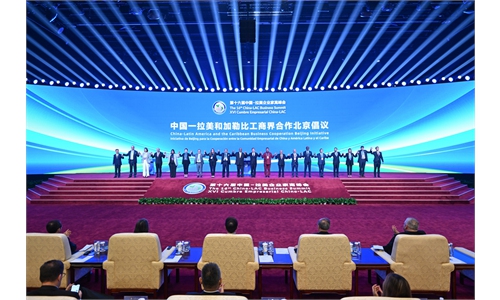China-LatAm tourism serves as bridge to ties
Closer bilateral people-to-people exchanges showcase practical BRI co-op

A view of the Plaza San Martin in Lima, capital of Peru on November 12, 2024 Photo: VCG
The number of Chinese tourists travelling to Latin American countries has steadily risen in recent years, making China one of the important source markets for Latin America, data from a number of travel platforms showed, a trend which industry insiders said is partly driven by the opening of more direct flights, closer economic ties as well as frequent cultural interactions between the two economies.
The closer people-to-people exchanges also represent an expansion of practical cooperation under the Belt and Road Initiative (BRI) between China and Latin American region, where a total of 22 countries have signed BRI cooperation documents with China to date, observers said. It is believed that upon Chinese leader's recent visits, the two economies will tap into the immense potential of tourism exchanges, further bridging people-to-people connectivity while also enriching the connotations of BRI collaboration at its 11th year of development.
The comments were made as the 31st APEC Economic Leaders' Meeting in Lima and the 19th G20 Summit in Rio de Janeiro are set to take place, which draws global attention to the two host countries, Peru and Brazil.
From January to October, orders for outbound trips to Latin America on travel agency Trip.com jumped by over 60 percent year-on-year, and among which, Brazil, Argentina, Peru, Colombia, and Chile were the top tourism destinations, the company said in a statement sent to the Global Times.
Peru, Argentina and Chile have signed the BRI cooperation documents with China.
The travel boom is partly fueled by the opening and resumption of multiple direct flights between China and Latin America, the company noted.
In addition to traditional travel hotspots, Chinese tourists are also showing strong interest in off-the-beaten-path tourist destinations and other BRI partner countries in Latin America.
A Honduran official said that since the Honduran Embassy in China opened last year, the embassy has been receiving daily inquires from Chinese citizens on topics such as how to travel to Honduras and how to apply for a visa, according to a People's Daily report.
China and Honduras established diplomatic relations in March last year, and the Latin American country signed a cooperation document on jointly building the BRI in June 2023.
Since the establishment of diplomatic relations between the two countries, mutual understanding and trust have deepened, and channels for mutual visits have gradually been established. As a result, many Chinese tourists have chosen to add Honduras to their travel wish lists, the official was quoted as saying in the report.
Allure to Chinese tourists
Xu Xiaolei, a marketing manager at China's CYTS Tours Holding Co, told the Global Times on Thursday that the number of Chinese tourists to Latin America has maintained double-digit growth in recent years. "The market has embarked on a rapid post-COVID recovery, and the uptick is particularly evident in recent long holidays such as the Spring Festival holidays," he noted.
He added that currently, most Chinese tourists to Latin America are aged between 40 and 60, and the group is mostly composed of high-end business travelers and those seeking in-depth independent travel experiences. Their trips typically last 15 days to 30 days.
According to industry insiders, the core attraction of Latin America trips to Chinese tourists lies in its unique natural landscapes and rich cultural heritage, such as jungles, forests and the Mayan civilization.
Also, as China-Latin America relations elevate further and the two sides strengthen practical cooperation under the framework BRI, it is a natural process that tourism, as a key component for deepening people-to-people exchanges among BRI partners, further facilitates "trans-hemispheric" interactions and bridges mutual trust and understanding.
As communication gains track, various tourism bureaus in Latin American countries have also been mulling over efforts to attract large number of Chinese tourists. Likewise, more and more Latin American tourists are looking forward to "China Travel."
Multi-layer BRI cooperation
Analysts stressed that BRI cooperation between China and Latin America is now standing at a historical starting point after the first golden decade of joint development. And in terms of the next decade of BRI high-quality development, the two sides will take Chinese leader's visit as an opportunity and resolutely forge ahead toward new horizon of collaboration, further demonstrating the bilateral relations as a model for South-South cooperation.
As such, in addition to mutual visits, industry insiders expect that bilateral tourism collaboration could take more forms such as tourism investment, operational expertise and technical exchanges, enriching the essence of multi-layer and broad-based people-to-people connectivity of BRI.
"More boutique travel routes will be launched in the future, paving the way for Latin American countries to attract more Chinese tourists. Also, travel authorities from each side could also consider making full use of the available flight resources and promote charter flight services," Xu noted.
It is expected that the two economies will strengthen people-to-people bonds under the BRI, and deepen bilateral economic and trade ties, thereby achieving common development and shared prosperity, analysts said.
The economic cooperation between China and Latin America has entered the fast lane in recent years. Chile's high-altitude cherries from the Andes made their global debut at the just-concluded China International Import Expo held in Shanghai. In addition, many Latin American star products, including Peruvian desert blueberries, have become top sellers in Chinese supermarkets.
Foreign Ministry spokesperson Mao Ning said at a press briefing last week that with the high-quality joint development of BRI between China and Latin America, "cross-hemisphere" exchanges between China and Latin America will become more convenient, and Latin American and Caribbean countries will discover more opportunities and achieve greater development in the Chinese market.




